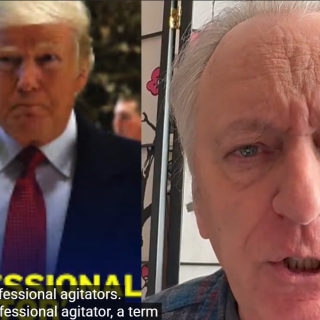Advertisement
A coalition of student organizations at Ohio State University (OSU) occupied Bricker Hall, the administrative building, on April 6 to #ReclaimOSU and demand that school officials release information about the university's investments and respond to campaigns by Real Food Challenge (RFC), United Students Against Sweatshops (USAS) or OSUDivest.
Despite OSU's status as a public university, the administration claims that the university's investments are a “trade secret,” and has refused to release the information. Student campaigns targeting unethical investments have been hampered by this lack of information.
The occupiers maintained their action in Bricker Hall during the day and into the night despite open intimidation from university officials. Faced with the threat of mass arrest and even expulsion from the universities, students decided to end the sit-in late that night, but the protests continued in the following days.
The coalition involved in #ReclaimOSU – which includes FemUNITY, Still We Rise, SHADES, Multi-Partisan Coalition, Committee for Justice in Palestine (CJP), OSU Coalition for Black Lives, International Socialist Organization, USAS and RFC – displayed a high level of unity during the occupation. But this didn't arise spontaneously – it was the product of a series of campaigns and actions that occurred over the past year.
Last fall, OSU, like other campuses across the nation, erupted in protest in solidarity with students at University of Missouri who were confronting university-sanctioned racism. "OSU2Mizzou" formed to stand with these students and push forward anti-racist demands at Ohio State. OSU2Mizzou mobilized more than 700 people in protest and led a seven-hour sit-in in the Ohio Union.
Months later, the Undergraduate Student Government (USG) released an internal demographics report that was marred by glaring statistical flaws and reporting errors. The administration signed a letter of solidarity written by OSU2Mizzou organizers, but there was no significant action.
Meanwhile, OSUDivest, an alliance of groups supporting the Palestinian struggle and the boycott, divestment and sanctions (BDS) campaign against Israel, was organizing OSU's ties to companies such as Caterpillar and Hewlett-Packard that are complicit in Israel's oppression of Palestinians.
During the 2014-15 school year, activists succeeded in getting the question of divestment put to a vote in a student referendum. But the USG came under fierce pressure from administration and BDS opponents, and disqualified 3,000 signatures through a retroactively enforced technicality, preventing students from voting on the referendum.
OSUDivest launched a second campaign during the 2015-16 school year, which brought together more than 20 student organizations to call on the USG to support divestment with a resolution. Pro-Israel supporters lobbied hard and were able to vote down the resolution after the intervention of Ohio government officials and the OSU administration.
Similarly, the OSU administration refused to respond to campaigns by RFC and USAS. RFC has called for OSU to commit 20 percent of its food budget to “real food” – which it defines as local and community-based, fair, humane and ecologically sound – by 2020. USAS has led a campaign opposing the privatization of OSU's energy facilities.
Both groups were promised meetings with the administration, but these were repeatedly canceled. When the groups finally did meet with administrators, none of their concerns were listened to. The fight to end privatization and the RFC 's campaign have broad support from faculty and students on campus, but neither has been considered by OSU's administration.
The general lack of response led organizers to realize that a united front would be necessary to gain student power at the university.
The #ReclaimOSU protest began with a rally at the Oval on the OSU campus on April 6, and drew more than 100 supporters.
The demonstration began with speeches by organizers from USAS, RFC and CJP, who described how the administration silenced student voices. Organizers then led the energized crowd into Bricker Hall and occupied the second floor outside President Michael Drake's office. Unsurprisingly, the door to Drake's office was locked, and Drake was nowhere to be found.
Students began an open mic, where a variety of speakers, including students, faculty members and workers at the university, spoke about their lack of power within the university structure.
Campus police had already established a presence in Bricker Hall before the protesters arrived, and their numbers grew larger as the protest continued. As soon as the occupation began, police prevented others from entering the building. They also refused to allow food or medicine to be brought in, despite campus police stating via Twitter that “accommodations (were) made for #ReclaimOSU students already inside to stay overnight.”
Jay Kasey, senior vice president of the Office of Administration and Planning at OSU, represented the administration in the conflict with protesters. He initially stated to sympathetic faculty that students could occupy the building as long as they wanted on the condition that they were peaceful. But as soon as faculty, workers and other observers left the occupation, the administration and police reneged on their promises.
The administration turned up the heat in the building to sweat protesters out. They also cut off any food from reaching protesters. Several students who tried to bring in food through the front door were pushed by an OSU police officer, Joanna Shaul.
Shortly after this encounter, Kasey informed protesters that President Drake “will never receive demands, and he will not negotiate with student protesters...If you are here at 5:00, our current philosophy is we are going to take you out, and escort you out of the building and arrest you. You will be discharged from school also. I am fairly confident of that, and I don't want you to be surprised.”
Kasey underlined his generosity when he stated that he would give students “the opportunity to go to jail for (their) beliefs.”
Despite the threat of arrest, spirits remained high. A Palestinian activist gave a presentation on his experience living in the Occupied Territories, protesters chanted a variety of slogans and organizers taught the crowd the Dabke, a Palestinian folk dance.
The demonstrators participating in the sit-in began calling on students and supporters to gather outside Bricker Hall, with the aim of having a large crowd outside by 4:30 a.m. to ensure their safety. When 50 people had gathered by 11 p.m., some of them setting up tents, administrators changed course again.
Around 11 p.m., the head of the campus police arrived, and Kasey commanded students to leave immediately or face arrest and expulsion. In what many took to be a veiled threat, he warned, “I assume some of you will want to stay, and we would have to lift you. Perhaps you'll flail, and then we'll have to be very, very careful that you don't harm yourself.” The occupiers decided to end the sit-in.
The next day, there was a #ReclaimOSU rally and press conference that included faculty members, who wrote and circulated a letter of solidarity condemning the use of intimidation and force by administrators. Five days later, some 425 faculty, adjuncts and graduate students had signed on.
The actions of #ReclaimOSU heavily politicized OSU’s campus in the following weeks.
On April 15th, students encountered a large chalking on the Oval stating, “Build the Wall” and “Trump 2016.” #ReclaimOSU and other students quickly organized a counter chalking and wrote out hundreds of messages of solidarity to counteract the xenophobic message.
On April 19th and 20th, #ReclaimOSU organized a series of teach-ins on the Oval to engage students and discuss with them the demands of #ReclaimOSU and student power generally.
And finally, on April 26, #ReclaimOSU hosted an event to wrap up the semester where nearly 100 students gathered together to write out their grievances with the university which were then given to President Drake. Protestors sang songs and proclaimed that, “We will be back!”
Despite the image of universities as democratic spaces where ideas are debated, the reality is very different, as the student struggle and the repression it has faced shows. At OSU, these antagonisms are very apparent – in part because the Board of Trustees is appointed by Republican Gov. John Kasich and is comprised largely of wealthy CEOs.
Ohio State is thus a magnet for the accumulation of capital. As socialists, we understand that this accumulation is neutral – it’s unethical, violent and nothing more than corporate greed packaged in buckeye micro-nationalism with a scarlet and gray bow in an attempt to leave Ohio State’s actions palatable and uncritiqued.
OSU is a textbook case of the neoliberal university, where any whiff of resistance is fanned away. But although the threats of arrest and expulsion did briefly stifle the occupation built by #ReclaimOSU organizers, activists are using the lessons of the experience to galvanize the OSU community to continue fighting for the university we deserve. Students will not stop organizing until those who make the university run actually run the university.



